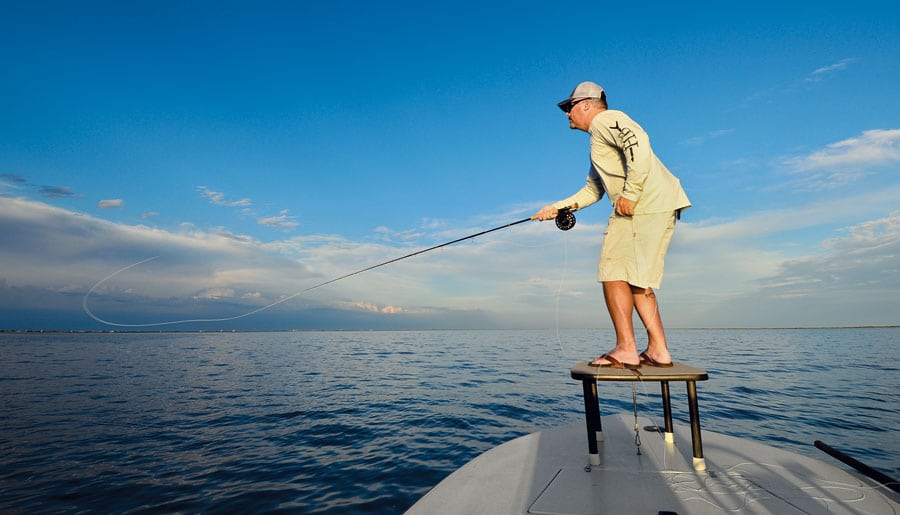
short casting
As you know, very few days on the water are perfect. More often than not, there is more wind than we would like, and if there is one cloud in the sky, well, that’s one too many.
All joking aside, cloud cover can not only block the sunlight from reaching the water but also cast a nasty glare that makes catching sight of fish difficult — especially when the water is murky or the fish are holding down deep. It goes without saying that in these conditions, spotting fish from a distance is a challenge, so most shots will likely be in close quarters. While making a shorter cast may sound easier than making a longer one, if you’ve ever thrown a fly rod, you know that making a 20- to 30-foot presentation to a fish that suddenly appears at 11 o’clock is actually very difficult because it’s quite hard to load a fly rod with only 10 to 12 feet of line.
Avoid the Rush
The first piece of advice that I offer for coping with this scenario is simple — slow down! When you are within 20 to 40 feet of a target and have to cast with an insufficient length of line, the biggest challenge is not the cast itself. Instead, the hardest part is making the presentation without spooking the fish. Just think of a great blue heron. When it fishes, it moves very deliberately right up until it slowly draws its head back and then suddenly strikes down at its prey. This action is quick, precise and made with minimal effort.
You must realize always that if you can see a fish, that fish can see you. To a fish at a distance, with the help of refraction, an angler and a boat are nothing more than a bump on the horizon. This obviously changes when you are standing over top of a fish. In this scenario, any sudden or frantic motion that draws the fish’s attention away from the hunt will cause it to look up and see your silhouette against the sky. All you can expect to see is a boil of mud as the fish heads for safety. Once you’re on top of a fish, the trick is to not give the fish a reason to look around for anything other than its next meal. Making slow and deliberate motions is the key to success.
When a fish appears all of a sudden, most people make a rushed, frenzied attempt to roll the fly out of their hand and in front of the fish. The mistake here is twofold. First, the fish can sense the hurried movements through the water as the skiff shudders when the angler moves. And second, the initial movement is made toward and over the fish. Fixing the first half of this two-part blunder is easy. Freeze, then assess the situation. In some cases, if you just stop, a fish will turn away from the boat and open up the distance, allowing for a longer, more accurate cast. More often than not, though, a short, precise cast is required.
**
Make It Happen**
When making short presentations, your first move should always be away from the fish. Beyond that, you must learn how to manipulate your gear so you can effectively cast with a short line.
The first and easiest way is to get a fly line that’s designed for short casts. In these lines, manufacturers have placed the required amount of weight to load a rod into a shorter head. With a good portion of the weight shifted to the end of the line, it allows fast loading for short casts.
Another way to load the rod more quickly for short presentations is to go about it in an old-school fashion and overline the rod. Before line companies began making specialty fly lines, anglers would sometimes put a 9-weight line on an 8-weight rod to achieve an accelerated load. In fact, at one time, I used to match a 9-weight line with a 7-weight rod to achieve a very aggressive short game.
While both of these methods are completely acceptable ways of making shorter casts, neither truly deals with a fish that is 15 to 30 feet away. This is where a water haul comes into play. A water haul is a method used to load the road by using the tension or resistance of the water against the line, leader and fly as they are pulled from the brine to provide a load for the rod.
When using a water haul, anglers can create a tight loop (necessary for accuracy and casting into the wind) with as little as 5 feet of fly line out of the rod tip. The trick is keeping the rod tip low to the water, moving it in a straight line and stopping it abruptly.
So let us put this technique to use. If a redfish or snook suddenly appears 20 feet away at 11 o’clock, don’t roll the fly out toward the fish. Instead, toss the it away from the fish and behind yourself; keep the rod low; and allow the line, leader and fly to fall to the surface of the water. This way, the water tension on the line, leader and fly will allow for a water haul on the forward cast, which will help create a tight loop (provided the rod tip moves in a straight line and comes to an abrupt stop). This will provide accuracy. Cast sidearm and keep the rod tip as low to the water as possible, and once the leader straightens, the fly won’t have far to fall, making for a softer presentation.









